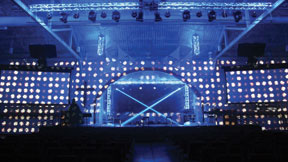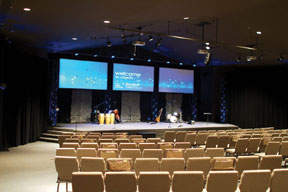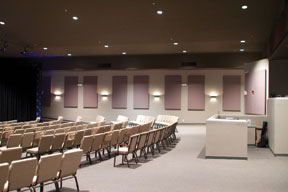
By RaeAnn Slaybaugh
It suffices to say that lighting the worship space isn’t an area of expertise for most pastors — yet, the final decision regarding what fixtures and elements to invest in often rests in their hands.
To help pastors navigate their choices, Church Executive spoke with a handful of church lighting experts: Duke DeJong, church relations director at Olympia, WA-based CCI Solutions; Douglas Hood, president of CSD Group, Inc. in Fort Wayne, IN; and
David Henry, Learnstagelighting.com creator and blogger.
Church Executive: What kinds of lighting fixtures are particularly popular in worship spaces? What kind of mood does each one create? And, how much can a pastor expect to spend?
Henry: Depending on the church’s style of worship, it may have (or need) any combination of conventional lights, LED lights and moving lights.
Conventional lights are non-moving, non-color-changing lights that have one attribute: They turn on and illuminate the stage.
 These can be colored and have patterns, or gobos, inside of them; but, their color or pattern can’t be changed without getting out a ladder! The price is generally $20 to $200 per light, but they require a dimmer (about $100 for four lights) if the church doesn’t already have a dimmer pack or rack.
These can be colored and have patterns, or gobos, inside of them; but, their color or pattern can’t be changed without getting out a ladder! The price is generally $20 to $200 per light, but they require a dimmer (about $100 for four lights) if the church doesn’t already have a dimmer pack or rack.
LED lights are the newer version of conventional lights in the sense that they don’t move. These color-changing lights use little power and are able to change colors from the console, during a service. However, because these lights don’t move, the church needs to get out the ladder if it wants them pointed somewhere else. Price ranges from $100 to $1,000 per light. Also, cheaper LED lights don’t look good on videotape.
Moving lights move and change colors and patterns. A church doesn’t have to get out a ladder for any re-pointing or re-coloring of these lights; it can do cool movements and effects during its worship service using these lights. They’re priced anywhere from $500 to $20,000 per light, but most cost less than $7,000 each.
All these lights can create the same types of looks or moods. From soft and dampened to bright, colorful and vibrant, they can do it all. The more expensive LED and moving lights can serve more purposes during a worship service, while a conventional light can only light one specific area at a time.
DeJong: Traditionally, the most common types of lights we see go into a house of worship are par can, ellipsoidal and house lights. [See page 16/Catalina Church North installation photos.] House lights come in all shapes, styles and power ratings, of course; but, the pendant-style fixture — which hangs down from a cord — has been more popular lately. What’s especially nice about pendant-style fixtures is, even if your ceiling has angle s or is open-truss, you can drop all the pendant lights to any given level and whatever’s above them just sort of “disappears.”
s or is open-truss, you can drop all the pendant lights to any given level and whatever’s above them just sort of “disappears.”
For stage lighting, the norm in churches has been par can and ellipsoidal fixtures. Par cans create a softer, more diffused and even wash over any given field. Ellipsoidal fixtures are more of a spot-type light, giving the ability to light more strategically over a specific field. Par cans used to be the standard just about everywhere; but, with the rise of projection, creative stage design and color washing backdrops, we’ve found that par cans don’t always give us the amount of control we want over our lighting. When light is needed in one area, but not in another, an ellipsoidal fixture offers the best control with a tighter beam, as well as the ability to shutter off part of the beam.
 In the last five to 10 years, LED fixtures have become increasingly popular as their prices have dropped. Trusted models range from $189 to $2,500 depending on brightness, size and so on. With their low power draw, low heat creation, increasing intensity — and with many having the ability to change to whatever color you want from a control surface — LED fixtures provide both energy savings and flexibility.
In the last five to 10 years, LED fixtures have become increasingly popular as their prices have dropped. Trusted models range from $189 to $2,500 depending on brightness, size and so on. With their low power draw, low heat creation, increasing intensity — and with many having the ability to change to whatever color you want from a control surface — LED fixtures provide both energy savings and flexibility.
Intelligent lights — in other words, fixtures that move (priced between $2,000 and $20,000 each) — are also gaining popularity as they become more affordable. With most intelligent fixtures being incredibly flexible and feature-rich, on top of being amiable from a control surface, more and more churches are incorporating intelligent lights into their systems.
 CE: Pastors might evaluate their lighting options in terms of longevity and versatility versus what might be the “flashiest” choices. What lighting elements would you recommend, with that criteria in mind — but that also offer some “flash”?
CE: Pastors might evaluate their lighting options in terms of longevity and versatility versus what might be the “flashiest” choices. What lighting elements would you recommend, with that criteria in mind — but that also offer some “flash”?
Hood: When talking about longevity and versatility, LED quickly pops up in any conversation. We’ve all heard of it, and we’ve all seen LEDs in use in churches, retail environments and outdoor lighting.
I love to include LEDs in our church designs because their colors can easily be changed — which is almost always on a church’s wish list, but which used to be complicated. At one time, it involved putting a gel frame holder on a theatrical light, and then putting a gel on that fixture. And even if you did all that, you still only had one color on that light. Beyond that, if you wanted to move the light, you had to get out a ladder, scaffolding or a motorized lift.
Now, churches can consider not only a LED light, but a moving-head LED light; so, the process is way easier. And, by using LED fixtures, the church doesn’t need a dimmer rack — no six-feet-tall racks of dimmers creating a big heat source in a back room, somewhere, and no special cooling system to cool that big dimmer rack.
DeJong: For many reasons, LED house and stage lighting is making more sense than ever — especially for new facilities. While they’re definitely a bigger upfront investment, LED lighting pays for itself in power and cooling savings. Plus, a church isn’t replacing lamps in its fixtures every year, which saves lamp cost and man hours. And, with many fixtures’ color flexibility, churches not only get a highly efficient and effective fixture, but they have flexibility to create ambience and mood with color.
CE: How does a pastor or business administrator know it’s time to upgrade the church’s lighting?
Henry: It’s time to upgrade when (a) you want it to do more than it can handle, or (b) it’s in a state of disrepair, and the cost of fixing it doesn’t make sense.
Pastors shouldn’t make major decisions without weighing the costs and work involved. And, they should keep in mind that upgrading to the latest technology is by no means required.
DeJong: It’s time to upgrade when the church is replacing lamps more often than it wants to; is looking to decrease its power consumption and cooling costs; sees an existing dimming system is beginning to fail; needs increased control of its lighting coverage; wants to add significant color to its lighting; wants to add effects lighting; and/or realizes its lighting controller no longer meets its needs.
Hood: If a pastor looks at his church’s platform/stage and would describe it as “underwhelming,” it might be time for an upgrade.
Ironically, it might also be time to upgrade if the worship environment is characterized by lots of plain white or beige walls. While those elements might be pretty boring to look at, adding a new LED lighting system really brings them to life. Imagine: If you shine a red light at a black surface, you’ll see red, to some degree. But, if you shine a red light at a plain white wall, the light really pops. That simple example helps paint the picture of what a professionally designed lighting system can do for even the most “blah” stage.
CE: Are there certain types of fixtures that stand the test of time and could be integrated into a (partially) new lighting scheme?
Henry: Yes! In fact, anything that’s in good, working condition and uses modern DMX protocol to communicate can become a part of a new system. The great thing about lighting is that the data and power standards have been in place for more than 25 years. So, many pieces of older equipment will seamlessly integrate with a new setup.
DeJong: Because most LED lighting fixtures last tens and even hundreds of thousands of hours, a church can feel pretty good about investing in LED fixtures. Although fans and dimmers built into those fixtures can fail, I believe LED fixtures offer the most bang for the buck, long-term. (Also, they’re incredibly flexible. So, if you no longer need them in one facility, you can always redeploy them to another venue.)
Par cans have also stood the test of time and are a great, basic lighting fixture. Ellipsoidal fixtures, too, have been a long-time standard in theatrical venues.
Hood: For most of our church clients, we still use a balance of incandescent (standard dimmable lights) and LED lights.
Typically, an incandescent system gives us the best general wash for the stage. We then supplement that base system with LED lights and intelligent lights for key light, back light, uplight, stage accents and architectural accents.
For most church clients, if the house lights are currently “doing the job” in terms of light output, we can reuse those. A new control system might be needed just so the overall system can be controlled easily, but a church can most likely keep the house fixtures. Many times, a church replaces its house fixtures because they’re dated, not because they don’t work.


